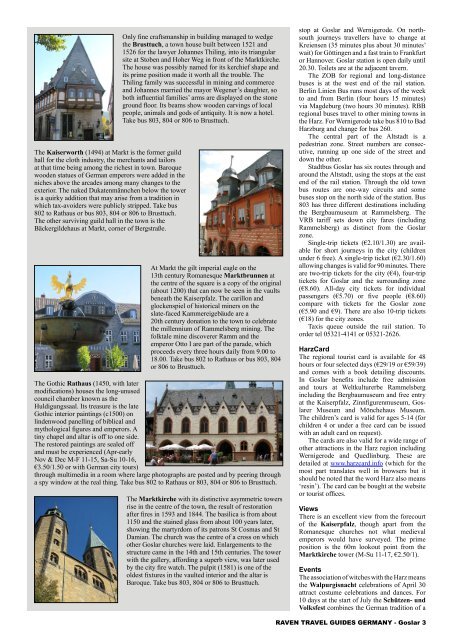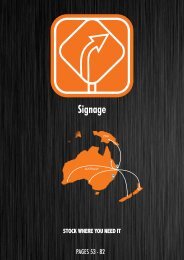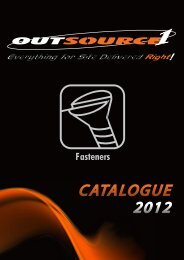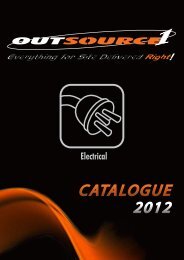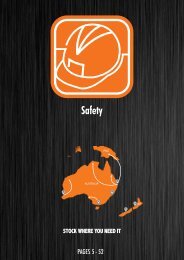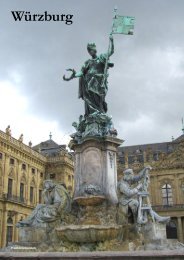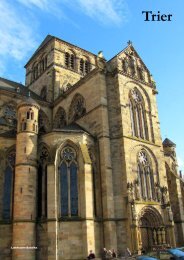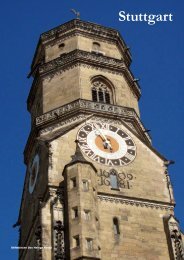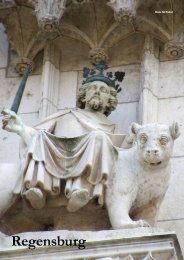Raven Guides: Germany - Goslar
Create successful ePaper yourself
Turn your PDF publications into a flip-book with our unique Google optimized e-Paper software.
The Kaiserworth (1494) at Markt is the former guild<br />
hall for the cloth industry, the merchants and tailors<br />
at that time being among the richest in town. Baroque<br />
wooden statues of German emperors were added in the<br />
niches above the arcades among many changes to the<br />
exterior. The naked Dukatenmännchen below the tower<br />
is a quirky addition that may arise from a tradition in<br />
which tax-avoiders were publicly stripped. Take bus<br />
802 to Rathaus or bus 803, 804 or 806 to Brusttuch.<br />
The other surviving guild hall in the town is the<br />
Bäckergildehaus at Markt, corner of Bergstraße.<br />
Only fine craftsmanship in building managed to wedge<br />
the Brusttuch, a town house built between 1521 and<br />
1526 for the lawyer Johannes Thiling, into its triangular<br />
site at Stoben and Hoher Weg in front of the Marktkirche.<br />
The house was possibly named for its kerchief shape and<br />
its prime position made it worth all the trouble. The<br />
Thiling family was successful in mining and commerce<br />
and Johannes married the mayor Wegener’s daughter, so<br />
both influential families’ arms are displayed on the stone<br />
ground floor. Its beams show wooden carvings of local<br />
people, animals and gods of antiquity. It is now a hotel.<br />
Take bus 803, 804 or 806 to Brusttuch.<br />
At Markt the gilt imperial eagle on the<br />
13th century Romanesque Marktbrunnen at<br />
the centre of the square is a copy of the original<br />
(about 1200) that can now be seen in the vaults<br />
beneath the Kaiserpfalz. The carillon and<br />
glockenspiel of historical miners on the<br />
slate-faced Kammereigebäude are a<br />
20th century donation to the town to celebrate<br />
the millennium of Rammelsberg mining. The<br />
folktale mine discoverer Ramm and the<br />
emperor Otto I are part of the parade, which<br />
proceeds every three hours daily from 9.00 to<br />
18.00. Take bus 802 to Rathaus or bus 803, 804<br />
or 806 to Brusttuch.<br />
The Gothic Rathaus (1450, with later<br />
modifications) houses the long-unused<br />
council chamber known as the<br />
Huldigungssaal. Its treasure is the late<br />
Gothic interior paintings (c1500) on<br />
lindenwood panelling of biblical and<br />
mythological figures and emperors. A<br />
tiny chapel and altar is off to one side.<br />
The restored paintings are sealed off<br />
and must be experienced (Apr-early<br />
Nov & Dec M-F 11-15, Sa-Su 10-16,<br />
€3.50/1.50 or with German city tours)<br />
through multimedia in a room where large photographs are posted and by peering through<br />
a spy window at the real thing. Take bus 802 to Rathaus or 803, 804 or 806 to Brusttuch.<br />
The Marktkirche with its distinctive asymmetric towers<br />
rise in the centre of the town, the result of restoration<br />
after fires in 1593 and 1844. The basilica is from about<br />
1150 and the stained glass from about 100 years later,<br />
showing the martyrdom of its patrons St Cosmas and St<br />
Damian. The church was the centre of a cross on which<br />
other <strong>Goslar</strong> churches were laid. Enlargements to the<br />
structure came in the 14th and 15th centuries. The tower<br />
with the gallery, affording a superb view, was later used<br />
by the city fire watch. The pulpit (1581) is one of the<br />
oldest fixtures in the vaulted interior and the altar is<br />
Baroque. Take bus 803, 804 or 806 to Brusttuch.<br />
stop at <strong>Goslar</strong> and Wernigerode. On northsouth<br />
journeys travellers have to change at<br />
Kreiensen (35 minutes plus about 30 minutes’<br />
wait) for Göttingen and a fast train to Frankfurt<br />
or Hannover. <strong>Goslar</strong> station is open daily until<br />
20.30. Toilets are at the adjacent tavern.<br />
The ZOB for regional and long-distance<br />
buses is at the west end of the rail station.<br />
Berlin Linien Bus runs most days of the week<br />
to and from Berlin (four hours 15 minutes)<br />
via Magdeburg (two hours 30 minutes). RBB<br />
regional buses travel to other mining towns in<br />
the Harz. For Wernigerode take bus 810 to Bad<br />
Harzburg and change for bus 260.<br />
The central part of the Altstadt is a<br />
pedestrian zone. Street numbers are consecutive,<br />
running up one side of the street and<br />
down the other.<br />
Stadtbus <strong>Goslar</strong> has six routes through and<br />
around the Altstadt, using the stops at the east<br />
end of the rail station. Through the old town<br />
bus routes are one-way circuits and some<br />
buses stop on the north side of the station. Bus<br />
803 has three different destinations including<br />
the Bergbaumuseum at Rammelsberg. The<br />
VRB tariff sets down city fares (including<br />
Rammelsberg) as distinct from the <strong>Goslar</strong><br />
zone.<br />
Single-trip tickets (€2.10/1.30) are available<br />
for short journeys in the city (children<br />
under 6 free). A single-trip ticket (€2.30/1.60)<br />
allowing changes is valid for 90 minutes. There<br />
are two-trip tickets for the city (€4), four-trip<br />
tickets for <strong>Goslar</strong> and the surrounding zone<br />
(€8.60). All-day city tickets for individual<br />
passengers (€5.70) or five people (€8.60)<br />
compare with tickets for the <strong>Goslar</strong> zone<br />
(€5.90 and €9). There are also 10-trip tickets<br />
(€18) for the city zones.<br />
Taxis queue outside the rail station. To<br />
order tel 05321-4141 or 05321-2626.<br />
HarzCard<br />
The regional tourist card is available for 48<br />
hours or four selected days (€29/19 or €59/39)<br />
and comes with a book detailing discounts.<br />
In <strong>Goslar</strong> benefits include free admission<br />
and tours at Weltkulturerbe Rammelsberg<br />
including the Bergbaumuseum and free entry<br />
at the Kaiserpfalz, Zinnfigurenmuseum, <strong>Goslar</strong>er<br />
Museum and Mönchehaus Museum.<br />
The children’s card is valid for ages 5-14 (for<br />
children 4 or under a free card can be issued<br />
with an adult card on request).<br />
The cards are also valid for a wide range of<br />
other attractions in the Harz region including<br />
Wernigerode and Quedlinburg. These are<br />
detailed at www.harzcard.info (which for the<br />
most part translates well in browsers but it<br />
should be noted that the word Harz also means<br />
‘resin’). The card can be bought at the website<br />
or tourist offices.<br />
Views<br />
There is an excellent view from the forecourt<br />
of the Kaiserpfalz, though apart from the<br />
Romanesque churches not what medieval<br />
emperors would have surveyed. The prime<br />
position is the 60m lookout point from the<br />
Marktkirche tower (M-Su 11-17, €2.50/1).<br />
Events<br />
The association of witches with the Harz means<br />
the Walpurgisnacht celebrations of April 30<br />
attract costume celebrations and dances. For<br />
10 days at the start of July the Schützen- und<br />
Volksfest combines the German tradition of a<br />
RAVEN TRAVEL GUIDES GERMANY - <strong>Goslar</strong> 3


